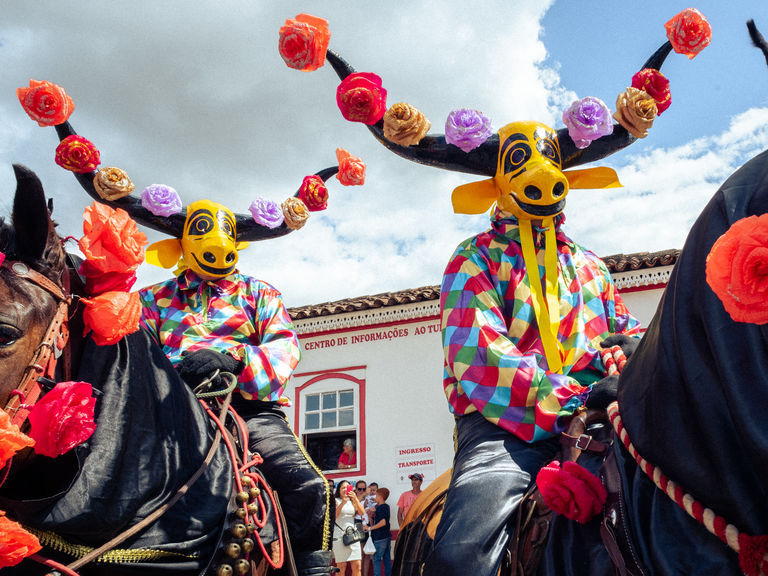Project Detail: Curucucús
Contest:
Swiss Storytelling Photo Grant 9th
Brand:
LuganoPhotoDays
Author:
Pierre Banoori
Project Info
Curucucús
1300 years later and on the other side of the planet, the European tales of Charlemagne have taken a life of their own in the depths of the Brazilian hinterlands. In the 18th century, Jesuits came to Brazil with the mission of catechising the indigenous and slave populations. To do so, they introduced a theatrical representation of the story of Charlemagne; consisting of a spectacle depicting Christian knights defeating Muslim moors: these are the Cavalhadas. Active participation in the festivities was reserved for the rich whites. But the slaves, the natives, and the general poor of Pirenópolis decided to take matters into their own hands. Covering themselves head to toe and masking their voices to remain unidentifiable, they would take to the streets to demonstrate and disrupt the festivities: they are the Curucucús. They have evolved to be the icons of the Cavalhadas de Pirenópolis.
Deep in the Brazilian hinterlands, Pentecost celebrations have taken a peculiar turn.
Tucked away in the mountains and crossed by the Rio das Almas (River of Souls), the town of Pirenópolis has celebrated Festa do Divino Espírito Santo - the equivalent of Pentecost in the Lusophone world- for over 200 years. It consists of the town’s main cultural event, well beyond February’s Carnaval. But here the festivities go beyond Pentecost, and climax with the Cavalhadas: a theatrical re-enactment of a legendary battle between the Christians and Moors that took place in Europe in the Middle Ages.
The extravagant display is rooted in the age-old poem “the song of Roland” – a 12th century French deed song that recalls the battle of Roncesvaux (778 BC). In the whole, the Cavalhadas act as an ode to Emperor Charlemagne, “King of the Franks”, as he put a stop to the Moors’ advances into France (and thus deeper into Europe), and how the late leader’s actions managed to inspire and unite fellow Christian kingdoms, which ultimately led to the expulsion of the Muslim Moors from the Iberian Peninsula.
Over three days, the Cavalhadas portray a battle between 12 Christian knights and 12 Muslim knights, which ends with the surrender and baptism of the Muslims.
Research indicates that Jesuit priests brought these celebrations over to Brazil in the 18th century in order to catechize the indigenous natives and African slaves, by showing them the power of the Christian faith.
It’s said that this folkloric festival has remained so strongly in Pirenópolis due to the fact that many of the Portuguese settlers that founded the town came from northern Portugal, a region historically known for its resistance against the Moors, but also “because the centralizing character of the dominant population welcomed the separatist effect between social classes.”
But beyond the splendor of the 24 knights, other characters have come to take centre stage during the Cavalhadas de Pirenópolis:
Over the three days of festivities, hundreds if not thousands of people take to the streets on foot and on horseback. Adorning masks, colourful clothes, gloves, and boots, and disguising their voices, they intend to be unidentifiable. Those on horseback also decorate their horses with ribbons, fabric, plants and much more – letting creativity run wild.
These are the “Mascarados”, or “Curucucús” – due to the raspy sounds they produce.
They use their anonymity to forgo all rules, to entertain, and to wreak havoc.
Although their origins are obscure and debated, there is a consensus that the Mascarados (meaning the masked ones) stem from the poor being barred from participating in the festivities. The role of the knights being reserved for the rich, the poor – specifically slaves - took matters into their own hands; disguising themselves and masking their voices, they took over the city streets to participate and celebrate in their own way. They would go further by causing unrest, chanting, and producing banners for political change.
It was essential to not show any part of their skin to remain unrecognizable, and thus be free of repercussions. Today they still take to the streets but also repeatedly enter the Cavalhodromo, which is the grand arena where the knights perform, to « disrupt » the festivities. They are called on to the field to entertain the public while the knights have a break, but are traditionally playfully stubborn when asked to leave the field – often staying on for much longer than desired.
“Brazilian festivals are typical expressions resulting from the history of formation of its people, since colonization, when an endless process of miscegenation began; Brazil begins to be a space of diverse cultural interconnections. The black, the white and the Indian mix, and positive and negative results emerge. The cultural massacre of enslaved Africans and indigenous people to the detriment of European culture is evident, and even today we can see traces of it within the parties in Brazil. In the Cavalhadas de Pirenópolis, a typical figure of this party, the so called "curucucus" or simply "mascarados" appeared so that blacks, Indians and the poor could participate in this party reserved only for rich whites. Covered from head to toe, they were not identified, and in this way, only in this way, could they demonstrate freely.” – Cassio Reis Barbosa, 2017.
Many different costumes are on display. The humanoid, jaguar and ox masks are believed to be the most historical and traditional. Ox masks are also found within other traditional festivities around north-eastern Brazil, and are associated with the rural, lower classes; those that raised cattle.
Over the years mask-making evolved into a flamboyant show of craftsmanship and artistry. Every year an award is given to the best mask. Even so, everchanging-times have given way to the infiltration of ready-made Halloween-type masks that some individuals don.
To counter this, children in Pirenópolis are given classes at school that teach them how to make masks out the traditional paper and wheat-flour glue.
Many - especially the youth- take advantage of the anonymity of being a Mascarado to drink all day, party until dawn, and bring about mischief without any consequences. Along this line, there have also been a number of cases of theft, violence, and sexual assault. The local government continues to tackle these issues; but one such resolve of obliging all Mascarados to wear a number (for identification purposes) was met with strong opposition from the public since it undermines the spirit of the festivities.
That is one side of the festival’s ongoing evolution. Organizers can be influenced, and politicians and businesses may get involved; Once sporting banners for political change, many Mascarados are now mostly seen waving banners that act as advertisements for businesses or that simply thank local politicians – and are likely paid to do so.
Cristiano da Costa has been participating in the Cavalhadas for over 40 years. Born in Pirenopolis in 1972, he has always looked forward to watching the show with his parents. In his eyes, the event “reinforces the bonds of friendship and fellowship, renews the faith of the Catholic population and injects great values into the economy of the municipality with employment and income.” Within his long-term experience of the festivities, Cristiano da Costa has witnessed quite a few changes over time: the restructuring of the Cavalhodromo (the grand arena where the spectacle takes place), but also the restructuring of the organization committee – there was a time when anyone could be an organizer, and this led to many politicians using the festivities as an electoral platform. Another significant change is that some folkloric groups receive funding from companies (for their clothing, horses, etc…). The sponsors then attempted to have their logos on the costumes; but this didn’t sit well with the spirit of the party nor the eyes of the public. Visible or not, the whole movement of having sponsors has also changed the dynamic of the participating folkloric groups; the fact that some groups receive financial aid has discouraged many others to even participate.
Old-timers tend to feel as if the Cavalhadas are no longer taken seriously enough, thus resulting in the loss of its essence. Invasive commercial and political motivations threaten its legacy. Even so, the hearts of the people involved remain full of spirit and the festivities overflow with fervour. The Cavalhadas de Pirenópolis continue to grow, bringing in an ever-growing number of attendees every year; not only from all corners of Brazil, but from the far reaches of the planet as well.
In addition: For the last 20 years (relatively recent), the second day of the Cavalhadas has become the day of the “Índios”. Boys and girls dress up in costumes that mimic indigenous attires, cover themselves in bodypaint and spend the morning and afternoon partying; boys on one side of the town and girls on the other. In the early evening they all convene at the Cavalhodromo and participate as Mascarados.
Author’s Note: In May 2023 I attended the Cavalhadas de Pirenópolis after thorough research regarding historical cultural links between Brazil and France. The very-European story of Charlemagne undergoes an unexpected representation & transformation, influenced by the endless charm, turbulent history, and wondrous creativity of the Brazilian people. With this little piece of French history being celebrated so far from its origins, the French government invited the knights of Pirenópolis to Paris in 2005 to perform their Cavalhadas.


















